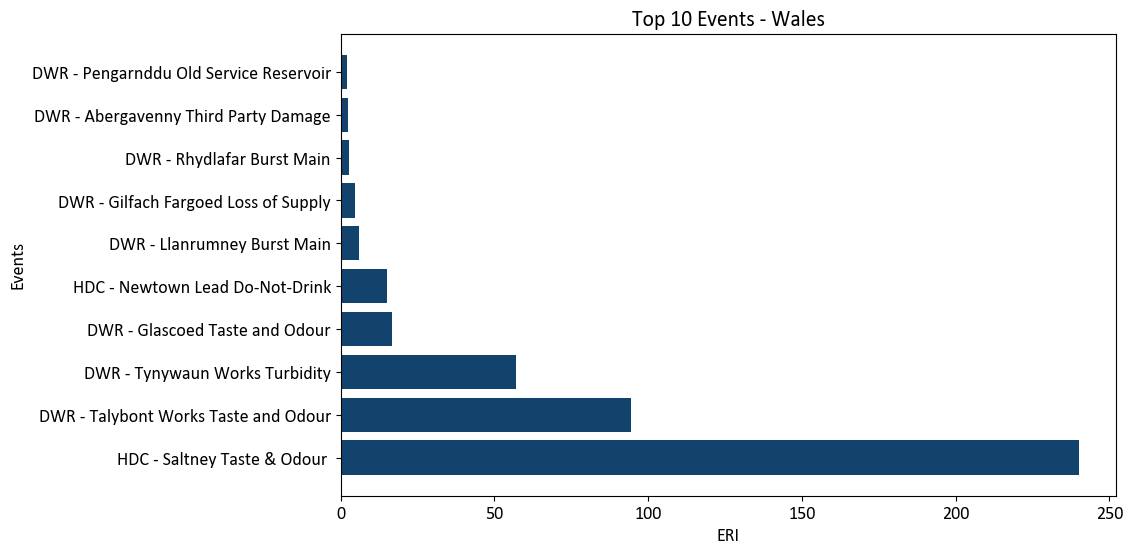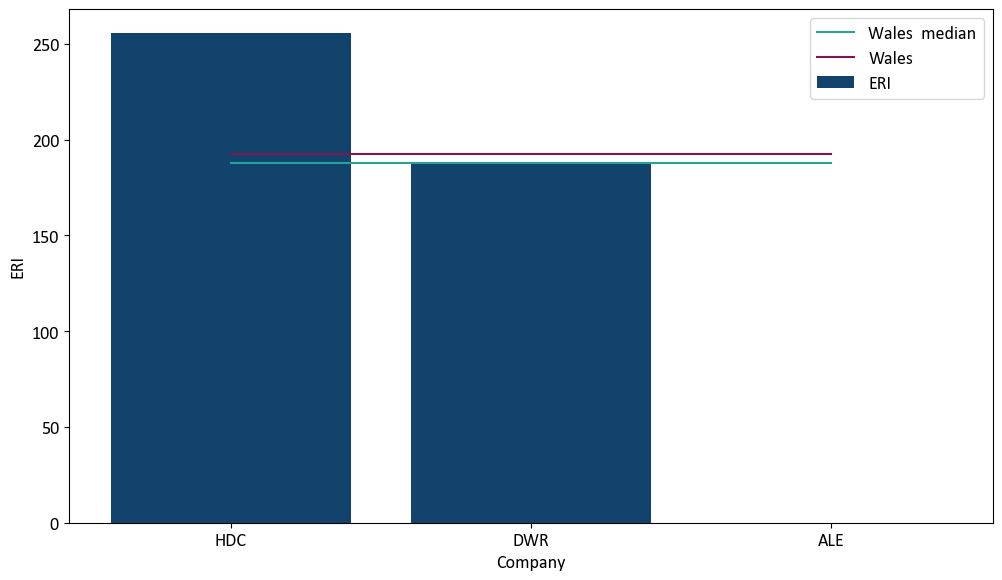- Drinking Water 2024 – Summary of the Chief Inspector’s report for drinking water in Wales
- Foreword
- Water supplies and testing
- Compliance with standards
- Learning from compliance failures
- Learning from events
- Consumer contacts
- Asset health
- Water safety planning and risk assessment
- Raw water
- Poly and perfluoroalkyl substances (PFAS)
- Audit programme
- Recommendations
- Enforcement
- SEMD
- NIS
- Materials in contact with drinking water (Regulation 31)
- Research publications
- Whistleblowers
- Working with stakeholders
- Annex A – Number of tests carried out by companies
- Annex B – Compliance with standards
- Annex C – Compliance failures and events
Learning from events
Water quality events infographic
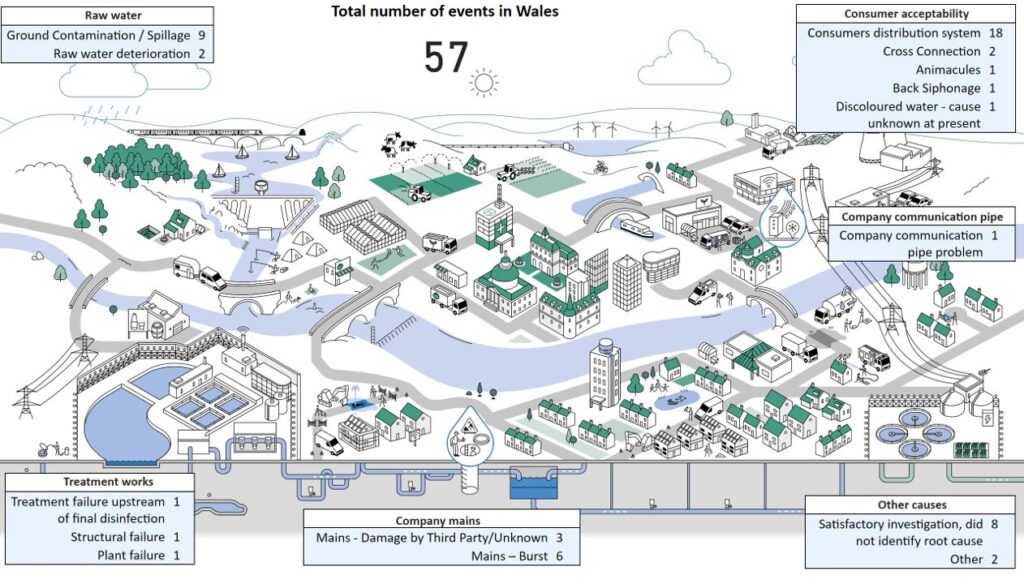
Figure 10 shows the highest scoring events in 2024. A small number of these event assessments are ongoing, therefore the assessment conclusions are estimated.
Most events notified to the Inspectorate in 2024 were of short duration with 45 of the 57 lasting less than 72 hours. Four of the top scoring events had a duration of greater than 200 hours which is more than eight days. The highest scoring event in 2023 was Dŵr Cymru Welsh Water’s Penyball works chlorate event, followed closely by a second chlorate event and its Penycefn works. These scored 12.294 and 8.096 respectively. In 2024, the top scoring event was Hafren Dyfrdwy’s Saltney taste and odour event with a score of 240.065. There are five events in 2024 scoring higher than the highest scoring event of 2023. The higher scores will have been caused by one or more of the ERI variables which include the seriousness score, assessment score and impact (population affected multiplied by duration of event). Figure 11 shows ERI for Wales in 2024.
A common theme in 2024 was network failures with associated consumer impact of loss of supply and/or discolouration in the Dŵr Cymru Welsh Water area. To minimise the impact of the loss of supply, the company employs alternative supplies commonly in the form of tankering, to infuse into the network or to fill service reservoirs. These activities have attracted recommendations regarding sampling requirements, particularly that tanker must be sampled at the point they discharge into the network.
Table 7. Top 10 scoring events notified in 2024
Company | Event name | Cause of event | Final event assessment | ERI score |
|---|---|---|---|---|
|
HDC |
Saltney Taste & Odour |
Treatment failure upstream of final disinfection |
4 |
240.065 |
|
DWR |
Talybont WTW Taste and Odour |
Raw water deterioration |
4 |
94.471 |
|
DWR |
Tynywaun WTW Turbidity |
Structural failure – Treatment works |
4 |
57.096 |
|
DWR |
Glascoed Taste and Odour |
Raw water deterioration |
3 |
16.664 |
|
HDC |
Newtown Lead Do Not Drink |
Company communication pipe problem |
4 |
15.03 |
|
DWR |
Llanrumney Burst Main |
Mains problem/ damage – Mains – Burst |
3 |
5.972 |
|
DWR |
Gilfach Fargoed Loss of Supply |
Mains problem/ damage – Mains – Burst |
4 |
4.599 |
|
DWR |
Rhydlafar Burst Main |
Mains problem/ damage – Mains – Burst |
4 |
2.737 |
|
DWR |
Abergavenny 3rd Party Damage |
Mains problem/ damage – Mains – Damage by Third Party/Unknown |
4 |
2.5 |
|
DWR |
Pengarnddu Old SRV |
Animacules |
1 |
2.09 |
Gilfach Fargoed Loss of Supply
A large-scale loss of supply event occurred following a burst on the inlet main to the Gilfach Fargoed service reservoir serving the Treharris area of South Wales. Company contractors were working in the area at the time to expose a section of the local wastewater network. During this excavation, the 24-inch cast iron main feeding Gilfach Fargoed service reservoir was damaged, resulting in a downstream loss of supply (Image 6 below).There were an associated 373 loss of supply and 105 discolouration contacts. The company repaired the main and conducted survey sampling, hydraulic modelling, rezoning, alternative supply and flushing operations to monitor and mitigate the impact on consumers. The event highlights the importance of understanding and mitigating the risks posed by planned excavations to critical underground supply infrastructure. It also serves to demonstrate the importance of contractor supervision and auditing to provide assurance of compliance with defined water quality and sufficiency risk mitigation processes during works.
Image 6 Fractured 24 inch main

Glascoed Taste and Odour
A taste and odour event occurred in May 2024 which was associated with the breakthrough of 2- methyl isoborneol (MIB) at Glascoed works. There are no dedicated granular activated carbon (GAC) adsorbers on site, but this media is incorporated into the site’s CoCoDAFF system. The company initiated powdered activated carbon (PAC) dosing and raw and treated water reconfiguration initiatives to eliminate and/or dilute MIB concentrations and flushing to mitigate the impact on consumers. A total of 14 consumer contacts were received in relation to the event. The taste and odour concentration triggers for operational interventions and investigation following detections at various process points were reviewed by the company and a new site-specific action plan was created. The reduction in taste and odour removal efficiency through the overloading of the granular activated carbon within the site’s CoCoDAFF system with coagulant floc, was identified as a contributing factor. The provision of acid dosing to facilitate a reduction in coagulant dose is planned to address this. The event highlights the importance of taste and odour compound treatment capacity provision and management. It also demonstrates the requirement to intervene with appropriate operational actions, such as the initiation of PAC dosing, at the earliest opportunity following apprehension of taste and odour contacts and/or compound concentration elevation.
Rhydlafar Burst Main
A burst on an 18-inch cast iron main on the outlet of Radyr service reservoir in Cardiff associated with damage caused by ground movement after heavy rain led to loss of supply and discolouration impacting 4,723 consumer properties on 18 October 2024. Rezoning and alternative supply operations were conducted to restore supplies. Elevated metals were detected in several survey samples including a tanker filling point and seven samples taken from active tankers which were taken out of service in response. Companies are encouraged to refer to the requirements of regulation 6 and consider the impact of such operations on both tanker and local up/downstream network water quality at the tanker filling and infusion points.
Barry Do Not Drink
A consumer contact from Barry Leisure Centre in February 2024, reported a strong chemical odour and reports of illness from consumers. The company issued precautionary do not drink advice on the day of apprehension, in response. On investigation during a Water Supply (Water Fittings) Regulations 1999 inspection (fittings inspection) on the same day and subsequent sampling surveys, contamination with corrosion inhibitors via a cross connection to the site’s heating system was identified. The company issued a Water Industry Act 1991 (the Act) section 75 notice to remediate the plumbing defects prior to resampling and rescinding of the do not drink notice. Companies are reminded of their duty under regulation 21 to pursue investigatory and enforcement actions, where appropriate, to prevent the recurrence of water fittings contraventions which have resulted in the supply of unwholesome water within a public building. This includes recurrence of water fittings contraventions at the property in question as well as at other buildings where work has been or could be conducted, for example where a third-party contractor is responsible for plumbing work across multiple public buildings. All instances of offences, offence investigations and decision making regarding the pursuance or otherwise of prosecution should be recorded in company systems.
Tynywaun Turbidity
At the end of November 2024, the South Wales valleys experienced a significant period of rainfall during Storm Bert with the equivalent of one month’s rainfall falling in Treherbert within a 48-hour period between 22 and 24 November 2024. The rain gauge at Tynywaun works, which feeds the Treherbert area, registered 172 mm of rain during this period. Over the course of the evening of 23 November 2024 the final water turbidity at Tynywaun began to rise and then exceeded 1 NTU whilst all upstream water quality trends were satisfactory. The site was running at a reduced disinfection stage capacity due to a compartment of the distribution cum contact tank being out of supply for inspection at the time. The operators identified a leak into the live contact tank compartment via a damaged joint and a decision was made to issue boil water notices to 28,525 consumers in the downstream zone. Subsequent sample surveys proved satisfactory in terms of microbiological compliance, including Cryptosporidium sampling from the works to consumers properties. Whilst timely electronic communications were made, the working time restrictions of the contracted courier company meant that the boil water notices were delivered to consumers two to three days after this decision was made. This advice continued until remedial works were completed on the out-of-supply contact tank compartment, it was returned to supply and continuing satisfactory sample results were obtained. The company did not include analyses for certain schedule 1 parameters such as hydrocarbons and pesticides in survey sampling based on a catchment occurrence risk assessment. Where surface water ingress into treated water holding structures is suspected or confirmed companies are encouraged to verify any associated risk assessments for schedule 1 parameters through appropriate reactive sampling. This event also highlights the importance of careful contingency planning to inform timely interventions in the event of the failure of stand-alone disinfection process assets. It also demonstrates the importance of regular inspection and maintenance activity to assure the integrity of disinfection and treated water holding assets.
Abergavenny boil water notices
During an investigatory response to a consumer water quality contact from the Forest Coal Pit area near Abergavenny, reactive samples from local properties indicated widespread microbiological contamination. A series of boil water notices were issued in response to these results. A mixture of supply arrangements were identified with properties variously on dedicated private supplies, a combination of public and private supplies (both live and disconnected) and public supply only. The properties on public supply were fed from a historic large bore outlet main for an upstream works that had been decommissioned in 2003. Flow, turn-over, free chlorine and pressures in the area from the now reversed flow supply, were low. The upstream decommissioned works had been isolated by valving in 2003, but a connected 1.4 km stagnant section of main was left at a higher elevation than the properties in question, creating the potential for pressure head. Leaks were identified on this stagnant main and an air gap was installed immediately downstream of the last property on the system to isolate this section of main from supply during the response to this event. The company has not been able to prove a definitive root cause for the event and has taken steps to improve local network turn-over and free chlorine. The investigation into this event demonstrates the importance of planning the decommissioning of supply assets to ensure that risks to local network water quality are not introduced.
Saltney taste and odour
Following a contamination event on a tributary of the River Dee the compound 2-isopropyl-3-methoxypyrazine broke through treatment at the receiving Severn Trent works. This led to a downstream taste and odour event in both the English and Welsh water quality zones in Chester. The consumer contact event reporting trigger for a hydraulically connected area was reached in the combined bulk supply fed Hafren Dyfrdwy and upstream Severn Trent water quality zone but notification of an event to the relevant authorities was raised for the Severn Trent area only. This breach of the requirements of regulation 35(6) resulted in a warning letter being issued to the company to prevent recurrence. Companies are reminded that, to comply with the requirements of regulation 35, water quality events which occur, or are likely to occur, on both sides of a bulk supply boundary should both be reported to the relevant authorities. The association with the upstream event should also be detailed in the event notification text for the bulk supplied area. Further details of this event that affected three water companies are in the taste and odour section of this report.
Newtown Lead
On 12 April 2024, Hafren Dyfrdwy took a lead investigatory sample at a consumer tap, with pre- and post-flush results of 688 µg/L and 20.21 µg/L, respectively. As the post-flush results were above 10 µg/L, the company responded by issuing do not drink advice to four properties on a shared supply whilst the lead services on both sides of the property boundary were replaced and satisfactory resamples taken.
However, the company had previously sampled this property in July and August 2022, at the request of the consumer. In August 2022, the pre-flush lead result was 4,885 µg/L, almost five hundred times greater than the lead standard of 10 µg/L. A filtered aliquot of this sample, and the flushed result were both below 10 µg/L. Flushing advice was issued in response with a single letter to each property on the shared supply; properties were not sampled again or subject to a supply pipe investigation until April 2024. Furthermore, during the investigation it was found that the water quality zone in which these properties were located had been rezoned to a supply which was not phosphate dosed. Phosphate dosing was listed as a control measure for lead in the company’s risk assessment. This rezoning had taken place prior to the sampling in 2022 and was not reversed until November 2023 and represented a significant period during which this control was absent. Companies are reminded that lead concentrations should be measured as total lead. A warning letter was sent to the company with further sanctions considered in case of repeat events of this nature.
Llanrumney Burst Main
In February 2024, a burst main occurred on Dŵr Cymru Welsh Water’s 15-inch trunk main supplying several areas of Cardiff. Initially, supply was lost to over 10,000 properties, however, the company was able to restore or maintain a piped supply to 4,095 of these properties by rezoning and to a further 1,187 properties by use of tankers. Seventeen tankers were deployed during the event, and issues were identified with the company’s compliance with regulation 6, with two demountable tankers not sampled at the commencement of distribution and instead sampled the following day, with one of these samples breaching the prescribed concentration for iron.
The burst point was located within 5 metres of a watercourse, the main was repaired and recharged. The company received 12 calls regarding water quality over two days, seven of which reported discoloured water. The company also received 146 contacts reporting no water.
Abergavenny third-party-damage
In April 2024 significant damage to an air valve on a high pressure 12 inch trunk main feeding the town of Abergavenny was caused by agricultural ploughing equipment being used in a field near the town. The air valve pipework was sheared at the tee connection to the trunk main causing catastrophic failure (Images 7 and 8 below). This led to a significant loss of supply and discolouration event across the downstream Abergavenny area. The company isolated and repaired the damaged assets, provided alternative supplies and conducted survey sampling to monitor and mitigate the impact on consumers. The scouring effect of the event on the local network led to short-lived elevations in manganese in downstream assets and properties. The company has a regulation 28(4) notice in place at the upstream Talybont works to improve manganese removal and has network flushing programmes for sediment removal. A Talybont trunk main conditioning program is also planned following completion of manganese removal improvements at the works. These elevations in manganese highlight the importance of viewing risks to water quality in terms of the entirety of the supply system, from catchment to consumer, to enable informed interventions at critical points to maximise benefit. The air valve in question was not classed as a critical valve and so was not subject to routine inspections. Companies are encouraged to ensure inspection, servicing, risk assessment and mitigation actions relating to air valves, including assessing the risk of potential damage caused by third parties, on critical trunk mains such as this are completed on a regular basis.
Images 7 and 8 Valve damaged in field

Pengarnddu Old Service Reservoir
Dŵr Cymru Welsh Water’s Pengarnddu Old service reservoir is a single compartment tank, constructed in 1915 and is a critical asset to supply water to the Merthyr Tydfil area. Originally an open tank, a roof was added around 40-50 years ago. There is no record of this tank ever having been drained down and inspected and the company has been unable to remove the tank from supply to complete this work, since this would impact supplies downstream. This service reservoir had single coliform breaches reported in both December 2021 and November 2023, both of which were not fully investigated since the tank could not be isolated or internally inspected. In 2018, the Inspectorate served a notice (DWR-2018-00002) to the company to build a new service reservoir asset to supply the Merthyr Tydfil area, and this work was completed in 2023. In 2022, the Inspectorate served a notice (DWR-2021-00002) to inspect all service reservoirs and tanks which had not been inspected in the previous 10 years, and this included Pengarnddu Old service reservoir. In September 2023, the new service reservoir, Pengarnddu no. 3, was brought into commission, allowing enabling works to begin on Pengarnddu Old service reservoir so that it could be removed from supply without impacting consumers. The tank was successfully removed from supply in June 2024, drained and a full internal inspection undertaken.
When completing the internal inspection, a large amount of debris was noted on the floor of the tank (Images 9, 10, 11 and 12 below), and when inspected, skeletal remains of an animal were discovered embedded within this sediment.
Images 9, 10, 11 and 12 Debris in service reservoir
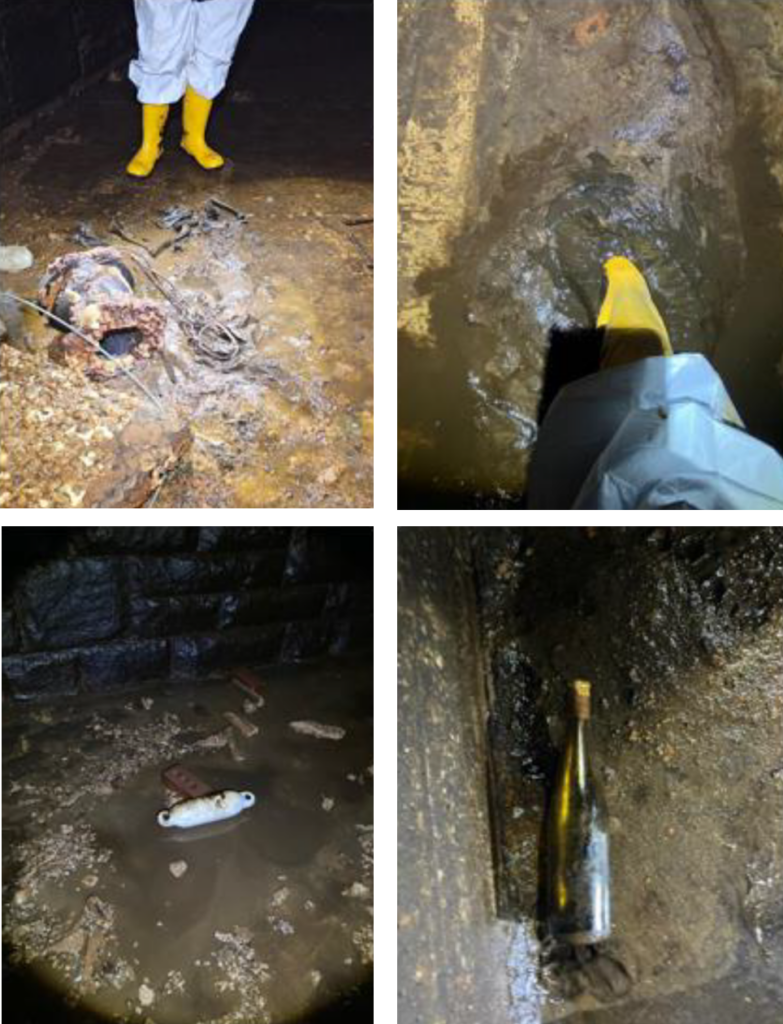
This was therefore reported to the Inspectorate as a water quality event. Since the tank had already been isolated, any risk posed to the general public had already been removed at that point. The remains were analysed in the laboratory and found to be that of a domestic dog. From the condition of these remains, it was thought that this had been in situ for a prolonged period (Images 13 and 14 below).
Images 13 and 14 Skeletal remains of a dog

Due to the extensive remediation required to bring this tank up to a satisfactory standard, this work is still ongoing, and this asset remains out of supply.
This case highlights the importance of regular inspection and maintenance of service reservoirs and tanks, including maintaining the ability to remove these assets from supply when necessary. Companies should regularly review their supply arrangements to ensure that changes to demand are accounted for in their risk assessments and in planning for inspections.
Morriston Do Not Drink
In June 2024, a Dŵr Cymru Welsh Water consumer reported a “sewage” and “foul” taste and odour in their supply. A company inspector attended the property the same day and noted an odour, but did not describe it as “sewage”; liaison with a water quality scientist did not take place and precautionary restriction of use advice was not issued at this time. Samples were taken the following day with results showing presumptive Clostridium perfringens present, and a do not drink notice was issued, two days after the initial call. A subsequent company water fittings inspection found a dead squirrel in the consumer’s uncovered hot water cistern (Image 15 below), at this point a do not use notice was issued which remained in place until remedial works had been completed.
Image 15 Squirrel in hot water tank

St Asaph Do Not Drink
In September 2024, a consumer in St Asaph, Denbighshire, contacted Dŵr Cymru Welsh Water to report a petrol like odour to their drinking water. An investigation was carried out by the company which identified elevated concentrations of hydrocarbon compounds, indicative of polycyclic aromatic hydrocarbon (PAH) contamination in the supply to the complaining property and one neighbouring property. The supply from other neighbouring properties on the same main was satisfactory.
PAH contamination of the water supply is rare, and when it does occur, is normally found to be caused by coal tar lining of iron water mains, accompanied by very low flow. In this case however, the source was identified as likely to be from a treated telegraph pole located in the vicinity of the supply pipes to the two affected properties and similarly treated railway sleepers used in planters on the grass verge outside of the two properties. Soil samples from around these sources confirmed contamination with similar PAH compounds (Images 16 and 17). A small section of blue plastic communications pipe connected the properties to the main ran near to the telegraph pole and underneath the planters and this has now been replaced. The rest of the supply pipe was found to be made from barrier pipe. During the investigation, both properties were given a restriction of use notice until the section of plastic pipe had been replaced, and satisfactory samples had been obtained.
Images 16 and 17 Excavation of communication pipe and main and planters constructed with railway sleepers on grass verge.
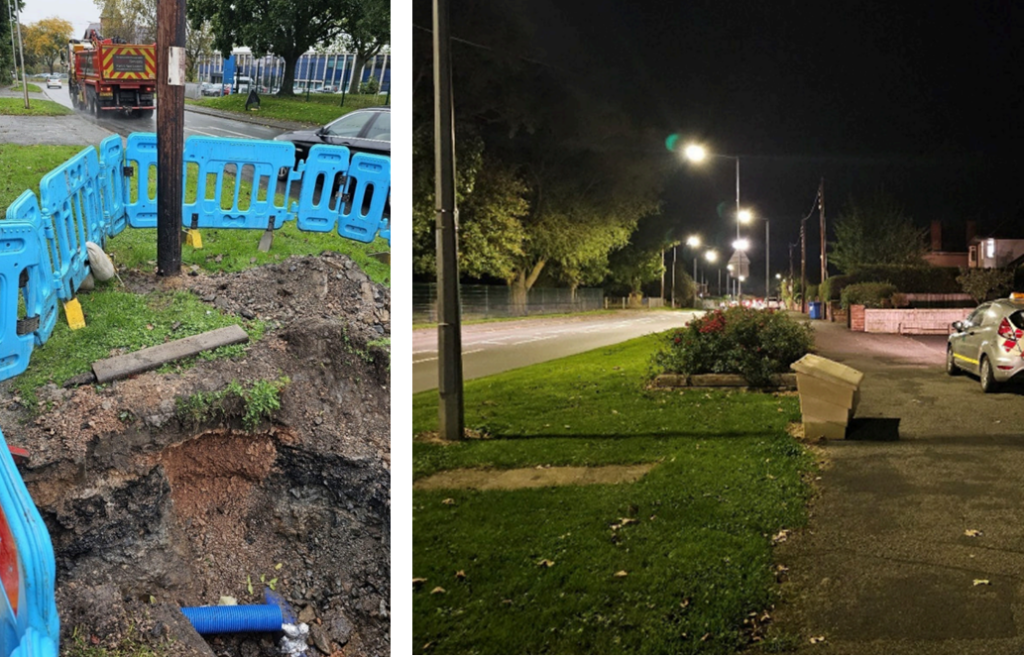
The company had previously received a similar complaint in 2020 from the same property, however the investigation carried out at the time did not correctly identify the cause and the investigation was closed prematurely, leaving the consumer at risk of drinking unwholesome water. Since then, the company has accepted an undertaking from the Inspectorate, for regulation 18 Investigations (DWR 2022-00002), and following this, a regulation 28(4) notice (DWR 2024-00007), also for regulation 18 investigations. The procedure for investigating petrol type taste and odour complaints has been reviewed and updated, thus the investigation in 2024 was significantly more comprehensive and robust, allowing the company to identify and resolve the issue for the consumers.

